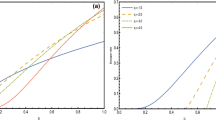Summary
The problem of solving the nonlinear stochastic differential equation for optical bistability with a positive correlation time (Ornstein-Uhlenbeck noise) is reduced to that of solving a Fokker-Planck equation which determines an approximation for the probability density valid to first order in the correlation time. The stationary states are analysed numerically to determine the effect of the positive correlation time on the bistability. Switching between the bistable maxima for stationary states is modelled by using Monte Carlo simulation techniques. Here too the positive correlation is seen to have an effect.
Riassunto
Il problema della soluzione dell'equazione differenziale stocastica non lineare per la bistabilità ottica con un tempo di correlazione positivo (rumore di Ornstein-Uhlenbeck) è ridotto a quello di risolvere un'equazione di Fokker-Planck che determina un'approssimazione per la densità di probabilità valida fino al prim'ordine nel tempo di correlazione. Gli stati stazionari sono analizzati numericamente per determinare l'effetto del tempo di correlazione positivo sulla bistabilità. L'interruzione tra i massimi bistabili per stati stazionari è modellato usando tecniche di simulazione di Montecarlo. Anche qui la correlazione positiva appare avere un effetto.
Резюме
Проблема решения нелинейного стохастического дифференциального уравнения для оптической биустойчивости с временем положительной корреляции (шум Орнстайна-Уленбека) сводится к проблеме решения уравнения Фоккера-Планка, которое определяет приближение для плотности вероятности, справедливое в первом порядке по времени корреляции. Численно анализируются стационарные состояния, чтобы определить влияние времени положительной корреляции на биустойчивость. Используя метод Монте Карло, моделируется переключение между биустойчивыми максимумами для стационарных состояний. Отмечается, что положительная корреляция также имеет место.
Similar content being viewed by others
References
H. M. Gibbs, S. L. McCall andT. N. C. Venkatesan:Phys. Rev. Lett.,36, 1135 (1976).
R. Bonifacio andL. A. Lugiato:Opt. Commun.,19, 172 (1976).
R. Bonifacio, M. Gronchi andL. A. Lugiato:Phys. Rev. A,18, 2266 (1978).
A. R. Bulsara, W. C. Schieve andR. F. Gragg:Phys. Lett. A,68, 294 (1978).
J. C. Englund, W. C. Schieve, W. Zurek andR. F. Gragg: inOptical Bistability, edited byC. M. Bowden, M. Ciftan andH. R. Robl (New York, N. Y., 1981), p. 315.
N. G. Van Kampen:Phys. Rep. (Phys. Lett. C),24, 171 (1976).
J. M. Sancho andM. San Miguel:Z. Phys. B,36, 357 (1980).
M. Shinozuka andC.-M. Jan:J. Sound Vib.,25, 111 (1972).
Author information
Authors and Affiliations
Additional information
To speed up publication, the author of this paper has agreed to not receive the proofs for correction.
Traduzione a cura della Redazione.
Переведено редакцией.
Rights and permissions
About this article
Cite this article
Moore, S.M. The effect of a positive correlation time on optical bistahility. Nuov Cim B 79, 125–139 (1984). https://doi.org/10.1007/BF02723843
Received:
Accepted:
Published:
Issue Date:
DOI: https://doi.org/10.1007/BF02723843




